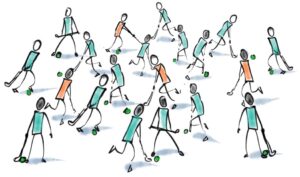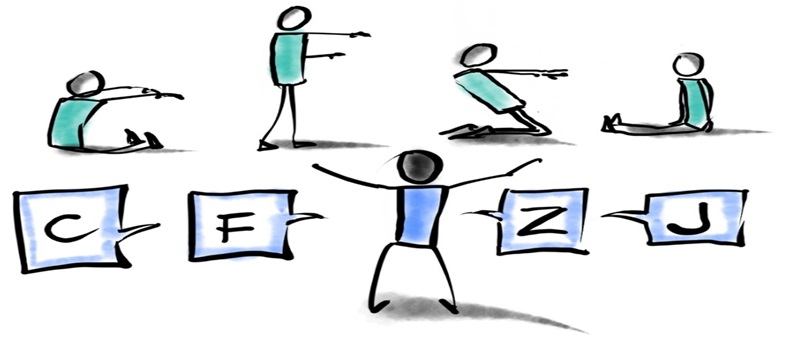Get lesson 1 of all sports: Sign up for a free pe planning membership
Hockey
Learning Objectives
- Continue to apply and develop a broader range of skills.
- Choose skills that meet the needs of the situation.
- Understand how physical activity can contribute to a healthy lifestyle.
Curriculum information
Literacy Keywords
- Score
- Work together
- Teamwork
- Explore the game
- Experiment
- Communication
- Team
- Stick
- Free space
- Direction
- Decision making
- Avoiding
- Pass
- Goal
- Dribble
- Defend
- Control
- Attack
- Tactics
- Ball
Citizenship
- Be a good team member
- Make informed choices about healthy lifestyles
- Develop own ideas and experiences
Equipment
- Marker cones
- Balls
- Hockey sticks
- Bibs
Risk Assessment
- Suitable clothing and footwear worn by participants.
- Equipment suitable for participants, safe and checked.
- Area safe and checked - any hazards removed.
- Safety information highlighted to participants.
- Staff aware of all emergency procedures, including designated 1st aider.
Knowledge Checks
Throughout this plan you will see ‘Knowledge Checks’ to help you ensure the pupils are acquiring the intended knowledge as the lesson progresses. The two types of knowledge to focus on in PE are:
- Declarative Knowledge: Factual knowledge concerning movement, rules, tactics, strategies, health and participation (best practiced through spoken or written observations of a practical demonstration).
- Procedural Knowledge: Knowing how to apply declarative facts (best practiced through demonstration or participation).
Teacher Notes
- This is the first lesson in the Hockey Unit of work.
- The intention of the lesson is to introduce the children to the new topic. It gives them the opportunity to experience the game and explore the skills they will be learning and developing in the unit.
- The main activity within the lesson incorporates many of the skills and tactics that will be covered in the unit. Playing the game in this
- lesson gives you the opportunity to make an initial assessment of your class. By observing the children, you can make a judgement on their current ability and plan your teaching for the rest of the unit accordingly.
- Introduce the hockey stick to the children and ensure they are familiar with safety rules that go with using it:
- The hockey stick is always to be kept below waist height.
- There should always be two hands on the hockey stick.
- The hockey stick should only be used in the designated way.
- The hockey stick should always be used safely and sensibly.
- Always be aware of who is around you when using a hockey stick – particularly if it is being swung.
- It should also be highlight that if the hockey stick is not used safely and sensibly it could result in somebody being hurt.
Activities & Games
Roundabout Madness
5 - 10 mins-
Set out a circle of cones 20 steps in diameter.
-
All children will need a hockey stick and 1 ball each.
- The children should dribble the ball around the outside of the circle.
- On the command “change” pupils change direction and travel the other way around the roundabout.

Teaching Points
- Dribble the ball at the ‘2 o’clock’ position.
- Keep your head up to avoid collision.
- Move slowly to start with then build speed gradually.
- Keep the ball in contact with the stick as much as possible.
- Take care when crossing the roundabout.
Progression:
-
Dribble in and out of the cones whilst travelling around the circle.
-
On the command “swap” pupils cut across the roundabout to a new space on the outside, avoiding collisions with other pupils.
-
Split the class into smaller groups, and challenge children to move quickly, overtaking if need, whilst keeping good control of their stick and ball.
To make activity harder:
- Speed up the activity – children can move past slower children in front of them but must keep their ball under control.
To make activity easier:
- Slow down the activity – only allow the children to walk.
Spy Tag
5 - 10 mins- Set out a 30 by 30 step area for the children to play in.
- Give each child a hockey stick.
- Select 4 children to be ‘Spies’ and give each of them a bib to wear – these children will not require a ball.
- Give all the remaining children 1 ball each.
- All children must stay in the playing area.
- Dribbling the ball around the area the children must try to stay away from the ‘Spies’.
- The ‘Spies’ aim is to try and touch the ball of one of the other children with their hockey stick.
- If their ball is touched a child must pick it up and stand still with their legs apart and their arms next to their sides holding their stick and ball.
- A child can be freed by another child passing their ball through the caught child’s legs – once freed they are free to re-join the game.

Teaching Points
- Hold your stick in 2 hands at all times.
- Try to keep the ball in contact with your stick.
- Change direction to avoid Spies and other children.
- Keep your head up to avoid collision.
- Change your speed to avoid being caught by the Spies.
- Keep your ball under control.
To make activity harder:
- Remove the bibs from the taggers. Or introduce more ‘Spies’.
To make activity easier:
- Reduce the number of ‘Spies’.
Knowledge Check
- PROCEDURAL KNOWLEDGE: Ask some children to demonstrate the activity/skill.
- DECLARATIVE KNOWLEDGE: Ask other children to describe what is required to perform the task with success.
Modified Hockey
15 - 20 mins- The aim of the game is to beat the opposition by scoring more goals.
- Play the game four against four and then five against five.
- Play on a pitch that is 15 to 20 steps wide, and 30 to 40 steps long.
- Position one goal at each end of the pitch, with a shooting area of about 5 steps by 5 steps around it.
- Play the game using hockey skills and rules.
- At first, play without goalkeepers and only allow players to shoot when they are in the shooting area.
- Later, allow players to shoot from outside the area and add goalkeepers.
- Encourage teams to think about how they need to change the way they organise themselves to attack and defend in the different games.
- Adaptations and variations.
- Play on a pitch with a larger or smaller shooting area.
- Play the game with only a limited number of players on each side allowed to score goals.
- Play with uneven sides, e.g. five against three or five against four, to make it easier for some children than others.
- Play with smaller goals, or only have a limited number of touches (for more able children).
- Play with bigger goals, more goals at one end, or fewer players so they have more time (for less able children).
Teaching Points
- Introduction or re-introduction to hockey/ invasion games.
- What skills do you need to use? Ask the children to think about this as they play the game.
- Experiment with different ideas and skills.
- How can you score points? Ask the children to think about this as they play the game.
- Observe children whilst playing the game – are they able to play it successfully?
- What areas do you need to focus your teaching on in the rest of the unit?
- SAFETY POINT: Use a suitable – SOFT ball that will not hurt the goalkeeper
- SAFETY POINT: Use the hockey sticks safely and sensibly.
- Explain the rules and how the game works then let the children explore the game for themselves.
- Let the children have a go at the game.

Letter Stretch
2 - 5 mins- The children should stand in a space on their own.
- Call out one of the hockey words from the warm up.
- The children must use their bodies to create each letter of the word, stretching their limbs and core.

Teaching Points
- Hold each letter for 8 seconds.
- Hold still, don’t bounce.
- Create the letter in a stretch, thinking about muscles being stretched.
Knowledge Check
What is an ‘Invasion’ Game?
- A game where a team invades another teams area and attempts to score points/goals in that area
What skills did you use to play the game today?
- Encourage the children to think of what they did to play the game.
What skills/ areas can you improve on?
- Encourage the children to think of skills/areas of the game that they could work on to improve their performance
Get lesson 1 of all sports: Sign up for a free pe planning membership